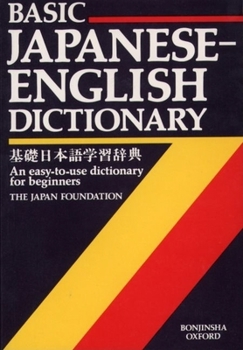Basic Japanese-English Dictionary
Select Format
Select Condition 
Book Overview
Designed specially for English-speakers in the early stages of learning Japanese, the Basic Japanese-English Dictionary fulfills an ever-growing need for an easy-to-use guide to introductory Japanese. Anyone visiting Japan or working to establish commercial or cultural links with Japanese people will welcome this flexi-covered dictionary.
The dictionary contains over 2,800 entries which, along with providing basic meanings and grammatical information, also distinguishes between senses, lists compounds, and gives sample sentences and idiomatic expressions. Based on Japanese language teaching materials, studies of vocabulary in common use, dictionaries and consultations with people involved in teaching Japanese as a foreign language, the selection of vocabulary focuses on words in everyday use. It presents all the Japanese words and phrases in roman script with standard Japanese script alongside and arranges the headwords alphabetically. It also includes an English translation on the right-hand side of each page to enable the student to compare the two languages. Cross-references direct the user to words of contrasting or related meaning, and, where necessary, the dictionary provides notes on special usage. It also includes a useful appendix which gives an introduction to Japanese grammar.
The Basic Japanese-English Dictionary will enable any new student of Japanese to understand more easily the basic vocabulary and to use it in the actual speaking and writing of the language.
The dictionary contains over 2,800 entries which, along with providing basic meanings and grammatical information, also distinguishes between senses, lists compounds, and gives sample sentences and idiomatic expressions. Based on Japanese language teaching materials, studies of vocabulary in common use, dictionaries and consultations with people involved in teaching Japanese as a foreign language, the selection of vocabulary focuses on words in everyday use. It presents all the Japanese words and phrases in roman script with standard Japanese script alongside and arranges the headwords alphabetically. It also includes an English translation on the right-hand side of each page to enable the student to compare the two languages. Cross-references direct the user to words of contrasting or related meaning, and, where necessary, the dictionary provides notes on special usage. It also includes a useful appendix which gives an introduction to Japanese grammar.
The Basic Japanese-English Dictionary will enable any new student of Japanese to understand more easily the basic vocabulary and to use it in the actual speaking and writing of the language.
Format:Paperback
Language:English
ISBN:0198643284
ISBN13:9780198643289
Release Date:March 1993
Publisher:Oxford University Press, USA
Length:974 Pages
Weight:1.72 lbs.
Dimensions:1.8" x 7.2" x 5.0"
Customer Reviews
4 ratings
Decent but...
Published by Thriftbooks.com User , 21 years ago
Its strength is the large amount of example sentences. You can learn a lot from this, but personally I find myself not using it very much. Whenever I need to look up a word, this dictionary very often falls short due to it only having 3 000 entries. I would instead recommend Kodansha's Furigana Japanese Dictionary (hardcover) which I recently bought and was positively surprised by. It has roughly 30 000 entries and many useful example sentences. 30 000 is infact not that much either; to find rare words you'd want one with 60 000+ entries as well. Also, this dictionary uses romaji while the Kodansha one does not. Romaji (Japanese written in the Roman alphabet) is clearly an evil to be avoided. It's tempting as a complete beginner to make use of romaji in one's studies, but imagine all the reading practise you are depriving yourself of. Once you get a bit of practise you will find that reading kana isn't very painful. The book does have Japanese script with furigana as well, but i find that it's hard to avoid reading the romanization. Also, this is one of those books that rudely closes itself automatically, while the Kodansha one doesn't. The binding is bad in my opinion. All this is atoned for somewhat by the low price (1103 pages for $13.27). But only if you're a complete beginner and too poor to get the Kodansha right now would i recommend buying it.
Excellent dictionary
Published by Thriftbooks.com User , 25 years ago
This dictionary is an invaluable reference to Japanese words. Many easy to understand examples of usage shown in English, Konji and Romanji.
Best Japanese Dictionary for the Student
Published by Thriftbooks.com User , 25 years ago
I have been the publisher for 3.5 years, and I have always suggested this dictionary as the best one for people who are just starting to master some Kanji and know the Kana well. Each entry is used in simple example Japanese language sentences, which I have found actually help the user learn more of the language each time the meaning of a new word is looked up. As a lexicographical text, it is useful to students, but perhaps not to scholars looking up arcane or technical expressions, but for anyone that is at the point where most texts and college courses leave you, this is a fantastic book.
A good beginners book for translating japanese to english
Published by Thriftbooks.com User , 25 years ago
This book is excellent for the beginner who only wants to translate japanese to english, as it is ONLY japanese-english. It does not contain especially many words, only 3000, but it covers the most usual phrases and words. One thing that is REALLY good is that the book is full of examples, sometimes 10-15 different for a word. All examples are written in romaji and KANA/KANJI. It also states the type of verb (I,II,III) which I personally find really useful. In the end of the book there is also a 30+ page introduction of japanese grammar, which is good. It is fun to read, due to the examples, and I use it together with my other dictionary which also has an english-japanese part. I find all words (almost) in that one, but I learn more from this.






